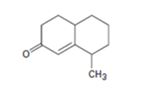
Concept explainers
a)

Interpretation:
How to prepare the cyclohexanone shown by combining a Stork enamine reaction with an intramolecular aldol condensation is to be shown.
Concept introduction:
The steps involved in the reaction are i) Reaction of the cyclic
To give:
How to prepare the cyclohexanone shown by combining a Stork enamine reaction with an intramolecular aldol condensation.
b)

Interpretation:
How to prepare the cyclohexanone shown by combining a Stork enamine reaction with an intramolecular aldol condensation is to be shown.
Concept introduction:
The steps involved in the reaction are i) Reaction of the cyclic ketone with pyrrolidine ii) Michael addition of enamine to cyclohexanone iii) A proton transfer iv) Hydrolysis of the enamine to eliminate the amine v) Abstraction of a proton from the diketone vi) Internal aldol reaction to form the second ring vii) Protonation and dehydration.
To give:
How to prepare the cyclohexanone shown by combining a Stork enamine reaction with an intramolecular aldol condensation.
c)

Interpretation:
How to prepare the cyclohexanone shown by combining a Stork enamine reaction with an intramolecular aldol condensation is to be shown.
Concept introduction:
The steps involved in the reaction are i) Reaction of the cyclic ketone with pyrrolidine ii) Michael addition of enamine to cyclohexanone iii) A proton transfer iv) Hydrolysis of the enamine to eliminate the amine v) Abstraction of a proton from the diketone vi) Internal aldol reaction to form the second ring vii) Protonation and dehydration.
To give:
How to prepare the cyclohexanone shown by combining a Stork enamine reaction with an intramolecular aldol condensation.
Trending nowThis is a popular solution!

Chapter 23 Solutions
ORGANIC CHEMISTRY-EBOOK>I<
- Consider the reaction of the cyclopentanone derivative shown below. i) NaOCH2CH3 CH3CH2OH, 25°C ii) CH3!arrow_forwardWhat constitutes a 'reference material', and why does its utilization play a critical role in the chemical analysis of food products? Provide examples.arrow_forwardExplain what calibration is and why it is essential in relation to food analysis. Provide examples.arrow_forward
- The cobalt mu-hydroxide complex cobaltate(III) of potassium is a dinuclear complex. Correct?arrow_forwardThe cobalt mi-hydroxide complex cobaltate(III) of potassium is a dinuclear complex. Correct?arrow_forward3. Arrange the different acids in Exercise B # 2 from the strongest (1) to the weakest acid (10). 1. 2. (strongest) 3. 4. 5. 6. 7. 8. 9. 10 10. (weakest)arrow_forward
- Name Section Score Date EXERCISE B pH, pOH, pка, AND PKD CALCULATIONS 1. Complete the following table. Solution [H+] [OH-] PH РОН Nature of Solution A 2 x 10-8 M B 1 x 10-7 M C D 12.3 6.8 2. The following table contains the names, formulas, ka or pka for some common acids. Fill in the blanks in the table. (17 Points) Acid Name Formula Dissociation reaction Ka pka Phosphoric acid H₂PO₁ H3PO4 H++ H₂PO 7.08 x 10-3 Dihydrogen H₂PO H₂PO H+ HPO 6.31 x 10-6 phosphate Hydrogen HPO₁ 12.4 phosphate Carbonic acid H2CO3 Hydrogen HCO 6.35 10.3 carbonate or bicarbonate Acetic acid CH,COOH 4.76 Lactic acid CH₂CHOH- COOH 1.38 x 10 Ammonium NH 5.63 x 10-10 Phenol CH₂OH 1 x 10-10 Protonated form CH3NH3* 3.16 x 10-11 of methylaminearrow_forwardIndicate whether it is true that Co(III) complexes are very stable.arrow_forwardMnO2 acts as an oxidant in the chlorine synthesis reaction.arrow_forward
- In Potassium mu-dihydroxydicobaltate (III) tetraoxalate K4[Co2(C2O4)4(OH)2], indicate whether the OH ligand type is bidentate.arrow_forwardImagine an electrochemical cell based on these two half reactions with electrolyte concentrations as given below: Oxidation: Pb(s) → Pb2+(aq, 0.10 M) + 2 e– Reduction: MnO4–(aq, 1.50 M) + 4 H+(aq, 2.0 M) + 3 e– → MnO2(s) + 2 H2O(l) Calculate Ecell (assuming temperature is standard 25 °C).arrow_forward: ☐ + Draw the Fischer projection of the most common naturally-occurring form of aspartate, with the acid group at the top and the side chain at the bottom. Important: be sure your structure shows the molecule as it would exist at physiological pH. Click and drag to start drawing a structure. ✓arrow_forward

 EBK A SMALL SCALE APPROACH TO ORGANIC LChemistryISBN:9781305446021Author:LampmanPublisher:CENGAGE LEARNING - CONSIGNMENT
EBK A SMALL SCALE APPROACH TO ORGANIC LChemistryISBN:9781305446021Author:LampmanPublisher:CENGAGE LEARNING - CONSIGNMENT

